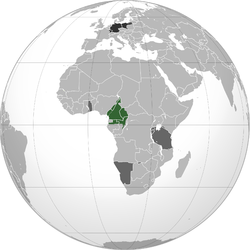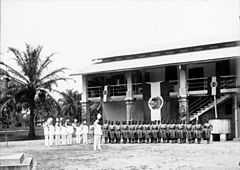Kamerun
| Cameroon | ||||||
| Kamerun | ||||||
| German colony | ||||||
| ||||||
| ||||||
 Historical German territory projected onto modern-day globe. Green: Territory comprising German colony of Kamerun. Dark gray: Other German territories. Darkest gray: German Empire. | ||||||
| Capital | Duala Buea (after 1910) | |||||
| Languages | German (official) Basaa · Beti · Duala Other local languages | |||||
| Government | Colony | |||||
| Governor | ||||||
| - | 1884 | Gustav Nachtigal | ||||
| - | 1887–1906 | Jesko von Puttkamer | ||||
| - | 1914–1916 | Karl Ebermaier | ||||
| History | ||||||
| - | Established | 1884 | ||||
| - | Disestablished | 1919 | ||||
| Currency | German gold mark | |||||
| Today part of | | |||||
German Cameroon (German: Kamerun) was a West African colony of the German Empire from 1884 to 1916 in the region of today's Republic of Cameroon. German Cameroon also includes northern parts of Gabon and the Congo with western parts of the Central African Republic, southwestern parts of Chad and far eastern parts of Nigeria.
History
19th century
The first German trading post in the Duala area (present day Douala) on the Kamerun River delta (present day Wouri River delta) was established in 1868 by the Hamburg trading company C. Woermann. The firm’s agent in Gabon, Johannes Thormählen, expanded activities to the Kamerun River delta. In 1874, together with the Woermann agent in Liberia, Wilhelm Jantzen, the two merchants founded their own company, Jantzen & Thormählen there.
Both of these West Africa houses expanded into shipping with their own sailing ships and steamers and inaugurated scheduled passenger and freight service between Hamburg, Germany and Duala.[1] These companies and others purchased extensive acreage from local chiefs and began systematic plantation operations, including bananas.
By 1884, Adolph Woermann, representing all West African companies as their spokesman, petitioned the imperial foreign office for "protection" by the German Empire. Otto, Fürst von Bismarck, the Imperial Chancellor, sought to utilize the traders on site in governing the region via "chartered companies". However, in response to the Fürst von Bismarck’s proposal, the companies withdrew their petition.[2]
At the core of the commercial interests was pursuit of profitable trading activities under the protection of the Reich, but these entities were determined to stay away from political engagements. Eventually Bismarck yielded to the Woermann position and instructed the admiralty to dispatch a gunboat. As a show of German interest, the small gunboat SMS Möwe arrived in West Africa.[3]
Protectorate of Kamerun
The protectorate of Kamerun was established during the period generally known as Europe’s imperialist "Scramble for Africa". The German explorer, medical doctor, imperial consul and commissioner for West Africa Gustav Nachtigal was the driving force toward the colony’s establishment. By then well over a dozen German companies, based in Hamburg and Bremen, conducted their trading and plantation activities in Kamerun.[4]
20th century
With imperial treasury subsidies, the colony built two rail lines from the port city of Duala to bring agricultural products to market: the Northern line of 160-kilometre (99 mi) to the Manenguba mountains, and the 300-kilometre (190 mi) long mainline to Makak on the river Nyong.[5] An extensive postal and telegraph system and a river navigation network with government ships connected the coast to the interior.
The Kamerun protectorate was enlarged with Neukamerun (German: New Cameroon) in 1911 as part of the settlement of the Agadir Crisis, resolved by the Treaty of Fez.
German losses
At the outbreak of World War I, French, Belgian and British troops invaded the German colony in 1914 and fully occupied it during the Kamerun campaign. The last German fort to surrender was the one at Mora in the north of the colony in 1916.
Following Germany's defeat, the Treaty of Versailles divided the territory into two League of Nations mandates (Class B) under the administration of Great Britain and France. French Cameroun and part of British Cameroons reunified in 1961 as Cameroon.
-

German surveyor in Kamerun, 1884.
-

Police force at Duala on the Kaiser's birthday, 1901.
-

Loading of bananas for export to Germany, 1912.
See also
- List of colonial heads of German Cameroon
- German West African Company
- History of Cameroon
- Neukamerun
- Index: German colonisation in Africa
- German South-West Africa
- Togoland
- German East Africa
Footnotes
Bibliography and references
- DeLancey, Mark W.; DeLancey, Mark D. (2000). Historical Dictionary of the Republic of Cameroon (3rd ed.). Lanham, Maryland: The Scarecrow Press. ISBN 0-8108-3775-7. OCLC 43324271.
- Gorges, E. Howard (1923). The Great War in West Africa. London: Hutchinson & Co.
- Haupt, Werner (1984). Deutschlands Schutzgebiete in Übersee 1884–1918 [Germany’s Overseas Protectorates 1884–1918]. Friedberg: Podzun-Pallas Verlag. ISBN 3-7909-0204-7.
- Hoffmann, Florian (2007). Okkupation und Militärverwaltung in Kamerun. Etablierung und Institutionalisierung des kolonialen Gewaltmonopols. Göttingen: Cuvillier Verlag. ISBN 9783867274722.
- "mainmap.gif (German Cameroons 1914)" (GIF). UniMaps. 2004. Map of the territories exchanged between France and Germany at the Treaty of Fez.
- Washausen, Helmut (1968). Hamburg und die Kolonialpolitik des Deutschen Reiches 1880 bis 1890. [Hamburg and Colonial Politics of the German Empire]. Hamburg: Hans Christians Verlag. OCLC 186017338.
- Jonas Bakoubayi Billy: Musterkolonie des Rassenstaats: Togo in der kolonialpolitischen Propaganda und Planung Deutschlands 1919-1943,J.H.Röll-Verlag, Dettelbach 2011, ISBN 978-3-89754-377-5
External links
| Wikimedia Commons has media related to German colony of Cameroon. |
| ||||||||||||||||||||||||||

